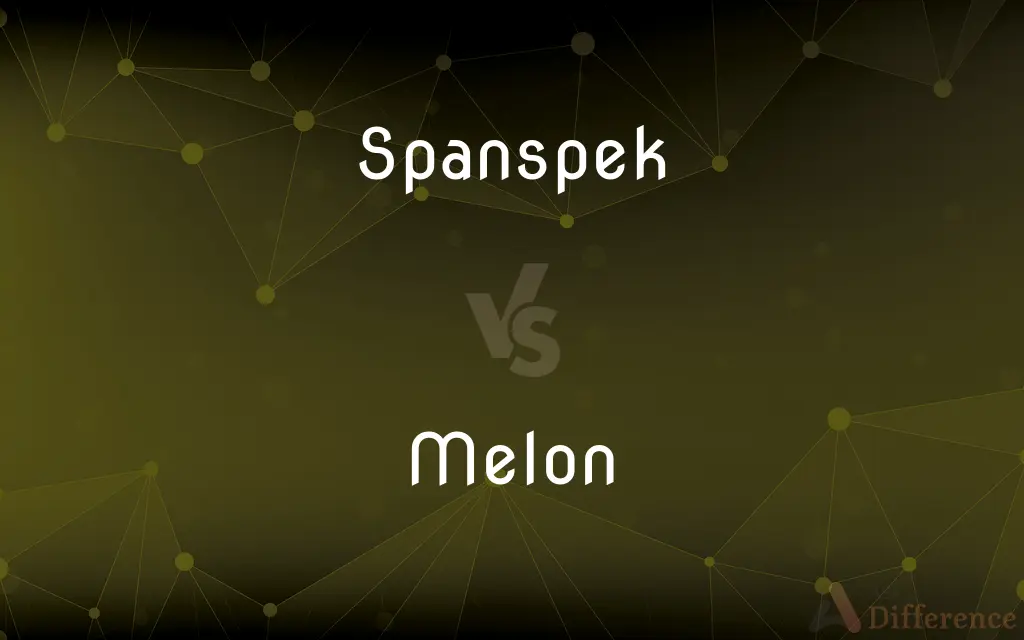Spanspek vs. Melon — What's the Difference?
By Urooj Arif & Fiza Rafique — Updated on April 3, 2024
Spanspek is a specific type of sweet melon, often compared to cantaloupe, while "melon" refers to a broader category of fleshy fruits within the Cucurbitaceae family.

Difference Between Spanspek and Melon
Table of Contents
ADVERTISEMENT
Key Differences
Spanspek, a term primarily used in South Africa, refers to a sweet melon variety closely resembling what is known in other parts of the world as cantaloupe or rockmelon. It is characterized by its round shape, rough skin, and sweet, orange flesh. Melon, on the other hand, is a general term that encompasses a wide range of fleshy fruits in the Cucurbitaceae family, including watermelons, honeydew melons, and cantaloupes, among others. While spanspek specifically denotes a particular variety within the melon category, the term melon covers a diverse group of fruits with various textures, flavors, and appearances.
Spanspek is known for its sweet and juicy flavor, making it a popular choice for breakfasts and desserts in South Africa. It is specifically a variety of cantaloupe that has adapted to local tastes and agricultural conditions. Melons, in contrast, can range widely in taste from the sweet flavors of honeydew and cantaloupe to the more neutral or slightly sweet taste of watermelons. This diversity makes melons versatile in culinary uses, from sweet dishes and salads to savory pairings with meats and cheeses.
Cultivation of spanspek, like that of other melons, requires warm, sunny environments and well-drained soils. However, spanspek's growth and flavor may be more closely tied to the specific climates and agricultural practices of regions where it is popularly grown, such as South Africa. Melons, being more diverse, are cultivated in a variety of climates around the world, from temperate to tropical regions, with each variety having its own specific growth requirements.
Nutritionally, spanspek shares many benefits with other melons, such as being high in vitamins A and C, fiber, and water content. This makes it, and melons in general, excellent for hydration and supporting overall health. However, the nutritional content can vary slightly among different types of melons, affecting their specific health benefits.
Despite their differences, spanspek and other melons share common challenges in cultivation, including susceptibility to pests and diseases like powdery mildew and cucumber mosaic virus. Farmers growing either spanspek or other melon varieties must manage these challenges to ensure healthy, productive crops.
ADVERTISEMENT
Comparison Chart
Definition
A type of sweet melon similar to cantaloupe, specific to South Africa.
A broad category of fleshy fruits including varieties like watermelon, honeydew, and cantaloupe.
Taste
Sweet, often compared to cantaloupe.
Ranges from sweet to neutral, depending on the variety.
Cultivation
Grows best in warm, sunny climates with well-drained soil, common in South Africa.
Grown in various climates worldwide, with specific requirements varying by type.
Nutritional Value
High in vitamins A and C, fiber, and water. Similar to other melons.
Nutritional content varies, generally high in vitamins, fiber, and water.
Culinary Uses
Popular in breakfasts and desserts in South Africa.
Used in a wide range of dishes, from salads to desserts and savory pairings.
Compare with Definitions
Spanspek
Often enjoyed in its raw form, either alone or in fruit salads.
A cold slice of spanspek is perfect on a hot day.
Melon
A general term for various types of large, fleshy fruits in the Cucurbitaceae family.
Watermelon is a popular type of melon in summer.
Spanspek
A variety of sweet melon similar to cantaloupe, known for its juicy orange flesh.
Spanspek is a favorite for a refreshing breakfast in South Africa.
Melon
Widely used in culinary applications, from sweet to savory dishes.
Melon pairs well with prosciutto for a classic appetizer.
Spanspek
Characterized by a rough, netted skin and a sweet aroma.
You can recognize spanspek by its distinctive netted rind.
Melon
Grown in diverse climates, from temperate to tropical regions.
Melons require warm weather and plenty of sunshine to grow.
Spanspek
Requires warm growing conditions similar to other melon varieties.
Spanspek thrives in the sunny climate of South Africa.
Melon
Known for their health benefits, such as being rich in vitamins and hydration.
A slice of melon can be a refreshing, healthy snack.
Spanspek
Offers numerous health benefits, including hydration and vitamins.
Eating spanspek is a delicious way to stay hydrated.
Melon
Includes varieties like cantaloupe, honeydew, and watermelon, among others.
Honeydew melon has a sweet, pale green flesh.
Spanspek
A cantaloupe.
Melon
The Old World plant which yields the melon.
Melon
A melon is any of various plants of the family Cucurbitaceae with sweet, edible, and fleshy fruit. The word "melon" can refer to either the plant or specifically to the fruit.
Melon
The large round fruit of a plant of the gourd family, with sweet pulpy flesh and many seeds
A slice of melon
A ripe melon will smell sweet
Melon
A waxy mass in the head of dolphins and other toothed whales, thought to focus acoustic signals.
Melon
Any of various vines of the family Cucurbitaceae, especially Cucumis melo or Citrullus lanatus, widely cultivated for their edible fruit.
Melon
The fruit of any of these plants, having a hard rind and juicy flesh.
Melon
A fatty structure in the forehead of cetaceans, especially the toothed whales, thought to be used in the production of high-frequency sounds.
Melon
Melons Vulgar Slang A woman's breasts.
Melon
(countable) Any of various plants of the family Cucurbitaceae grown for food, generally not including the cucumber.
Melon
Genus Cucumis, various musk melons, including honeydew, cantaloupes, and horned melon.
Melon
Genus Citrullus, watermelons and others
Melon
Genus Benincasa, a winter melon
Melon
Genus Momordica, a bitter melon
Melon
(uncountable) Fruit of such plants.
Melon
(uncountable) A light pinkish orange colour, like that of some melon flesh.
Melon
Breasts.
Melon
The head.
Think! Use your melon!
Melon
A member of the Green Party, or similar environmental group.
Melon
(countable) A mass of adipose tissue found in the forehead of all toothed whales, used to focus and modulate vocalizations.
Melon
(chemistry) The result of heptazine being polymerized with the tri-s-triazine units linked through an amine (NH) link.
Melon
Of a light pinkish orange colour, like that of melon flesh.
Melon
The juicy fruit of certain cucurbitaceous plants, as the muskmelon, watermelon, and citron melon; also, the plant that produces the fruit.
Melon
A large, ornamental, marine, univalve shell of the genus Melo.
Melon
Any of numerous fruits of the gourd family having a hard rind and sweet juicy flesh
Melon
Any of various fruit of cucurbitaceous vines including: muskmelons; watermelons; cantaloupes; cucumbers
Common Curiosities
How should spanspek be stored for optimal freshness?
Like other melons, spanspek should be stored in a cool, dry place or refrigerated once cut to maintain freshness.
Are all melons sweet?
Most melons have a sweet flavor, but the intensity varies among types, with some like watermelon having a more subtle sweetness.
What are the main health benefits of consuming spanspek and melons?
They are high in water content and vitamins, making them excellent for hydration and nutritional intake.
Can spanspek be used in the same recipes as other melons?
Yes, spanspek can often be substituted in recipes calling for cantaloupe or similar melons due to its sweet taste and texture.
Is there a difference in the nutritional value between spanspek and other melons?
While all melons are nutritionally similar, offering hydration and vitamins, minor differences may exist based on variety and ripeness.
How do cultural preferences influence melon consumption?
Cultural preferences can dictate the popularity of certain melon varieties, such as spanspek in South Africa, based on local tastes and culinary traditions.
Why is spanspek particularly popular in South Africa?
Its adaptation to the local climate and taste preferences makes spanspek a favored choice among South African melons.
What makes spanspek different from other melons?
Spanspek is a specific variety of sweet melon, similar to cantaloupe, particularly cherished in South Africa for its flavor.
How do you pick a ripe spanspek or melon?
For spanspek and most melons, look for a fruit that feels heavy for its size, has a fragrant aroma at the stem end, and gives slightly under pressure.
Can melons be grown in any climate?
While melons prefer warm climates, certain varieties can be cultivated in temperate zones with the right care.
Share Your Discovery

Previous Comparison
Fatherland vs. Motherland
Next Comparison
Caper vs. HeistAuthor Spotlight
Written by
Urooj ArifUrooj is a skilled content writer at Ask Difference, known for her exceptional ability to simplify complex topics into engaging and informative content. With a passion for research and a flair for clear, concise writing, she consistently delivers articles that resonate with our diverse audience.
Co-written by
Fiza RafiqueFiza Rafique is a skilled content writer at AskDifference.com, where she meticulously refines and enhances written pieces. Drawing from her vast editorial expertise, Fiza ensures clarity, accuracy, and precision in every article. Passionate about language, she continually seeks to elevate the quality of content for readers worldwide.
















































